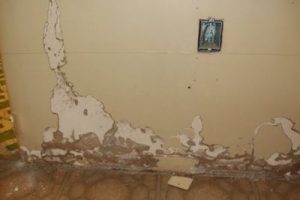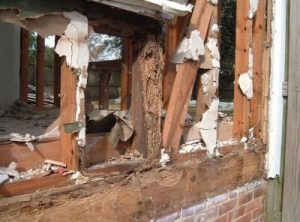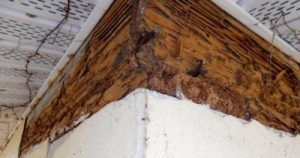
When termites feast on rotten tree stumps or a useless log in a yard, it doesn’t seem like a huge problem.
Yet, if they infest walls or a floor, it should be a warning to you because in a while they can eat all the floor and walls inside out, including load bearing ones, which will eventually lead to obvious consequences.
Thus their activity must be fought against.
Hide content
- Signs of infestation
- Evidence of Termite Damage on Sheet Rock
- A few more facts about wall infestation
- How fast can they eat my wall?
- Photo
- Useful articles
- Helpful video
- Conclusion
Signs of infestation
Needless to say that signs of termite infestation of walls and the floor have a lot in common with signs of their infestation of other places.How to determine termite damage in wall? These are the things that should warn you:
- There’s mud-like material, mixture of soil, their feces and saliva, lining the galleries in an irregular pattern.
- Appearance of alates (aka flying termites or swarmers), whose aim is to start new colonies indoors. It’s not that hard to distinguish termite swarmers from flying ants; unlike ants termite swarmers’ waists are as thick as the rest of the body and all wings are of the same size.
- Piles of wings. After alates mate, they shed their wings. If their wings are found, it means that this vermin has probably made the way in.
- Drywood termites push out small fecal pellets, resembling salt and pepper mixture, out of the nest.
- Subterranean termites can build mud tubes from their nest to the source of wood (which your wall can become).
If you find such a tunnel on a concrete block surface, stretching from below towards a wooden wall or a floor, it means that this very wall has become their free buffet.
The tubes’ “mud” is not actually mud, but the building material mentioned above: the mixture of soil, feces and saliva.
You should remember that absence of the tubes does not mean absence of the termites, i.e.
Drywood termites can simply inhabit the wall or a floor and don’t show from in there.- Live termites. It isn’t even worth mentioning that if you see a termite, 1/4″ long, wingless and white creeping through a crack, it means that this one made this wall his home.
- Buckling paint or tiny holes on a wood wall or a floor.
- Dull, hollow sound of a wood when tapped. As you know, termites start eating a wood from depths to subsurface, therefore the larger the part they’ve already consumed the more distinct the hollow sound is.
- Papery rustling, dry rattle coming from a wall or a floor. It means that they are inside. When threatened, termite start banging heads against surface and this cause rattling, whereas rustling is a result of tunneling near the surface.
- Sagging floor. Having lost structural integrity, floor can become really unsteady.
Learn more about drywood termites: signs of their activity; best methods of treatment: spot treatment and DIY methods; how to get rid of them in furniture?
Evidence of Termite Damage on Sheet Rock
As it’s been mentioned million times, termites typically eat walls from inside out, so there’re very few signs of infestation on walls exterior.
But sometimes they leave small holes in sheetrock paper. You may see small bits of dirt where subterranean termites have made minute holes in sheetrock paper.
However, it’s not so easy to tell these holes apart from well just usual holes.These are the most common signs of termite wall damage, now let’s speak about other interesting facts that should be taken into consideration whilst detecting termite in the walls.
A few more facts about wall infestation
There’re two ways termites may infest a wooden wall: flying in and accessing from the ground.
Drywood termites can send an alate who will bury themselves into the wall and establish a new colony in there, whereas Subterranean termites can lay a mud tunnel into it and go inside for food.
Thus, the walls in contact with soil are much more susceptible to Subterranean termite infestation than those which are not.
Because walls are thinner than other parts of a house, the infestation in them advances faster, severely damaging structural integrity of them and consequently the house itself. On the picture you can see the evidence of termite damages drywall.
Laminated plywood or particle board are often rapidly affected.Learn more about subterranean termites: signs of their activity; best methods of treatment and DIY methods. Eastern subterranean termites and their tunnels and tubes with photo.
How fast can they eat my wall?
The answer is: it depends. Firstly, it depends on the level of moisture, then it depends on how “ripe” the colony is – it usually takes about two years for a colony to grow to a threatening size of 60,000 species.
Subterranean ones multiply faster than Drywood does and can get into millions within a few years. According to estimates, one termite consumes 1 square foot in about 3.1 years (though Formosan termites are more gluttonous).
So, simple arithmetic says that a colony of 60,000 species can eat a square foot in around 52 days, so you’ll just have to multiply this number by your wall volume to find out how fast these insects can finish it.However, you should know that this estimate is very rough.
Here you can learn more information about effective treatment method called tenting (fumigation): dangers for termites, preparing for fumigation and cleaning after, how long does this procedure last?
Photo
What does termite damage look like in drywall? You can see termite damage in drywall on pictures below:
Useful articles
If you interested in more information of termites we recommend you to read the following articles:
- All types of termites. Are they harmful to humans? Can they bite you? And what is the difference between drywood and subterranean ones?
- What does swarmers of different species look like: drywood, subterranean, formosan?
- Signs of infestation outside and in the house: in walls or furniture.
- What does termite holes look like? What is droppings and is it toxic to humans? Do termites make noises?
- Posible termite damage, how does it look like? Examples of damage of wood floors.
- All about flying termites: how do they look like, swarming season and what to do if there are swarmers in your house?
- How do they do nests and mounds? How to find it in your garden or inside the house?
- Termite life cycle – from egg to larvae. And social hierarchy: workers, soldiers, queen.
Helpful video
Quick video of subterranean termite damage in a foreclosed home:
Conclusion
In sum, termite wall infestation is nothing different from infestation of any other kind.
- pellets;
- mud tubes;
- shed wings;
- dull sound when tapping;
- tiny holes;
- piles of wings;
- live termites
are the thing that should ring the bell.
It will take eternity for a colony to completely devour the entire wall, but if you take a hands-off approach, in a while wholeness of the wall or a floor may be affected severely enough to cause collapse, and Formosan termites eat wood especially quickly.









